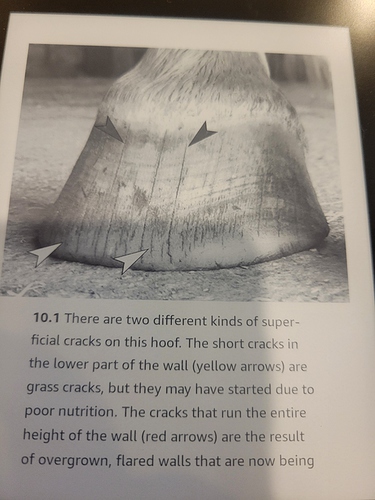I bought a mare a couple of years ago from a different state, and she came to me with very, very thin vertical cracks on all of her hooves, that were very superficial. She’s had a total change of diet, trimming, and management, yet the cracks remain. It’s interesting to me because she had the cracks with her breeder as a baby, and with the person I bought her from, and now with me. If it is husbandry related, I would assume this issue would have fluctuated with her different living environments, but it hasn’t. Right now she is on Triple Crown Balancer Gold, Timothy hay pellets, free choice salt, and low sugar hay. Her water is also filtered for excess iron. In the past, I had tried her on vitamins/minerals and flax along with the hay pellets, and no change. She has a barefoot trimmer, but the farriers she had prior to me were Amish and traditional farriers. No thrush. Not one little crack or crevice. 24/7 turnout unless there is inclement weather.
Can anybody explain why these cracks would still be present throughout so many dietary/environmental changes (I think for the better)? She does have white hooves, but I hear it’s a myth that white hooves are different quality. Thanks, all!



 . I will probably have to wait until the sun emerges sometime next week.
. I will probably have to wait until the sun emerges sometime next week. Hmm, let’s see - I got her with the cracks in September '22. They improved somewhat over the next several months with good and regular trims, but still persisted up into the new growth. I want to say that at the end of the summer (Aug/Sept '23) my farrier mentioned the bacteria. I started treating with Durasole and within one or two cycles the cracks started to get a bit tighter and her hooves were generally ‘hanging together’ better. So that was 6 months ago? That timeline seems to track with general hoof growth. She is barefoot and has AMAZING feet now.
Hmm, let’s see - I got her with the cracks in September '22. They improved somewhat over the next several months with good and regular trims, but still persisted up into the new growth. I want to say that at the end of the summer (Aug/Sept '23) my farrier mentioned the bacteria. I started treating with Durasole and within one or two cycles the cracks started to get a bit tighter and her hooves were generally ‘hanging together’ better. So that was 6 months ago? That timeline seems to track with general hoof growth. She is barefoot and has AMAZING feet now.